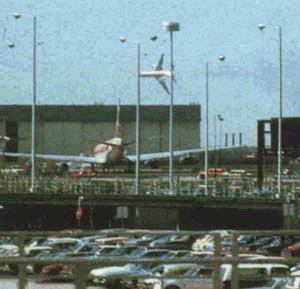
Date: May 25, 1979 Type: DC-10-10 Registration: N110AA Operator: American Airlines, Inc. Where: Chicago-OUHare International Airport Report No. NTSB-AAR-79-17 Report Date: December 21, 1979 Pages: 103 About 1504 c.d.t., May 25, 1979, American Airlines, Inc., Flight 191, a McDonnell-Douglas DC-10-10 aircraft, crashed into an open field just short of a trailer park about 4,600 ft northwest of the departure end of runway 32R at Chicago-O'Hare International Airport, Illinois. Flight 191 was taking off from runway 32R. The weather was clear and the visibility was 15 miles. During the takeoff rotation, the left engine and pylon assembly and about 3 ft of the leading edge of the left wing separated from the aircraft and fell to the runway. Flight 191 continued to climb to about 325 ft above the ground and then began to roll to the left. The aircraft continued to roll to the left until the wings were past the vertical position, and during the roll, the aircraft's nose pitched down below the horizon. Flight 191 crashed into the open field and the wreckage scattered into an adjacent trailer park. The aircraft was destroyed in the crash and subsequent fire. Two hundred and seventy-one persons on board Flight 191 were killed; two persons on the ground were killed, and two others were injured. An old aircraft hangar, several automobiles, and a mobile home were destroyed. The National Transportation Safety Board determines that the probable cause of this accident was the asymmetrical stall and the ensuing roll of the aircraft because of the uncommanded retraction of the left wing outboard leading edge slats and the loss of stall warning and slat disagreement indication systems resulting from maintenance-induced damage leading to the separation of the No. 1 engine and pylon assembly at a critical point during takeoff. The separation resulted from damage by improper maintenance procedures which led to failure of the pylon structure. Contributing to the cause of the accident were the vulnerability of the design of the pylon attach points to maintenance damage; the vulnerability of the design of the leading edge slat system to the damage which produced asymmetry; deficiencies in Federal Aviation Administration surveillance and reporting systems which failed to detect and prevent the use of improper maintenance procedures; deficiencies in the practices and communications among the operators, the manufacturer, and the FAA which failed to determine and disseminate the particulars regarding previous maintenance damage incidents; and the intolerance of prescribed operational procedures to this unique emergency.
